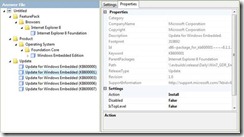Windows Embedded Standard 7 Servicing Overview
Introduction
Compared to XPe, there will be an increased number of options for servicing Windows Embedded Standard 7 runtime images, Distribution Shares, and tools. This article will give a brief overview of what will be offered for servicing in Standard 7. Note that there may be more in-depth coverage on some of these topics in future articles, so in the meantime we encourage you to leave a comment here or ask any specific questions you might have on the Windows Embedded Standard forums.
Adding Updates in Image Configuration Editor
The first servicing scenario you’ll likely have to deal with is deciding which updates to include when creating your image, in order to ensure maximum security and reliability. As the number of updates grows over time, the task of determining which updates should or should not be added to an image becomes increasingly time-consuming. Fortunately, the Image Configuration Editor (ICE) in Windows Embedded Standard 7 offers a simple solution: functionality to add only those updates which are applicable to the features in your answer file.
From the “Validate” menu, select “Add Applicable Updates.”
All applicable updates will then be placed into your answer file. Note that you can find out which feature caused the updated to be brought into the answer file by checking the ParentPackages field under the Properties tab.
Developer Tools and Distribution Share Servicing: ECE, MOO, and Windows Embedded Developer Update (WEDU)
The next logical question to ask is: how do these updates get into the Distribution Share? While updates will still be available for download via Embedded Communications Extranet (ECE) and Microsoft OEM Online (MOO) as in XPe, Standard 7 will also offer a new option known as Windows Embedded Developer Update (WEDU).
WEDU allows the developer to automatically download and import updates into the Distribution Share as soon as they become available. WEDU is also able to update to the developer tools, such as Image Configuration Editor. WEDU is available from the Microsoft Download Center, and more information can also be found here.
Windows Update
New for Standard 7 is that it will have the ability to use Windows Update to update devices directly, similar to desktop PCs. In Standard 7 however, this will be an optional feature. Note that Windows Update will require that the device have internet access.
Servicing Directly on the Device: PkgScn and DISM
If your device is not connected to the internet or if you decide you do not want to use Windows Update for any other reason, then there is still an easy solution for servicing: command-line tools that can be run on the device itself. In-depth information on how to use these tools was covered in a previous blog articles: Package Scanner – Command Line Servicing for Windows Embedded, and Updating Your Windows Embedded Standard Image Using DISM.
Service Packs
Unlike XPe, Standard 7 will have the ability to install a Service Pack instead of having to wipe and reload the device. As with Service Packs for desktop PCs, the purpose is to offer all updates up to a point in time rolled up into a single package file.
With the wide array of options for servicing offered in Standard 7, we’re confident that it will be easier than ever before to keep your embedded devices up to date. Thanks for reading this article, and please leave any questions or comments you might have below.

